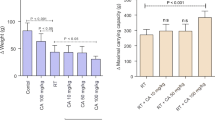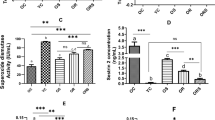Abstract
The effect of short-term creatine (Cr) supplementation upon content of skeletal muscle-derived-reactive oxygen species (ROS) was investigated. Wistar rats were supplemented with Cr (5 g/kg BW) or vehicle, by gavage, for 6 days. Soleus and extensor digitorum longus (EDL) muscles were removed and incubated for evaluation of ROS content using Amplex-UltraRed reagent. The analysis of expression and activity of antioxidant enzymes (superoxide dismutase 1 and 2, catalase and glutathione peroxidase) were performed. Direct scavenger action of Cr on superoxide radical and hydrogen peroxide was also investigated. Short-term Cr supplementation attenuated ROS content in both soleus and EDL muscles (by 41 and 33.7%, respectively). Cr supplementation did not change expression and activity of antioxidant enzymes. Basal TBARS content was not altered by Cr supplementation. In cell-free experiments, Cr showed a scavenger effect on superoxide radical in concentrations of 20 and 40 mM, but not on hydrogen peroxide. These results indicate that Cr supplementation decreases ROS content in skeletal muscle possibly due to a direct action of Cr molecule on superoxide radical.



Similar content being viewed by others
References
Aebi H (1984) Catalase in vitro. Methods Enzymol 105:121–126
Aoki MS, Lima WP, Miyabara EH, Gouveia CH, Moriscot AS (2004) Deleterious effects of immobilization upon rat skeletal muscle: role of creatine supplementation. Clin Nutr 23:1176–1183
Azzi A, Montecucco C, Richter C (1975) The use of acetylated ferricytochrome c for the detection of superoxide radicals produced in biological membranes. Biochem Biophys Res Commun 65:597–603
Bassit RA, Pinheiro CH, Vitzel KF, Sproesser AJ, Silveira LR, Curi R (2010) Effect of short-term creatine supplementation on markers of skeletal muscle damage after strenuous contractile activity. Eur J Appl Physiol 108:945–955
Bradford MM (1976) A rapid and sensitive method for the quantitation of microgram quantities of protein utilizing the principle of protein-dye binding. Anal Biochem 72:248–254
Casey A, Constantin-Teodosiu D, Howell S, Hultman E, Greenhaff PL (1996) Creatine ingestion favorably affects performance and muscle metabolism during maximal exercise in humans. Am J Physiol 271:E31–E37
Deldicque L, Louis M, Theisen D, Nielens H, Dehoux M, Thissen JP, Rennie MJ, Francaux M (2005) Increased IGF mRNA in human skeletal muscle after creatine supplementation. Med Sci Sports Exerc 37:731–736
Dröge W (2002) Free radicals in the physiological control of cell function. Physiol Rev 82:47–95
Feldman EB (1999) Creatine: a dietary supplement and ergogenic aid. Nutr Rev 57:45–50
Flohé L, Günzler WA (1984) Assays of glutathione peroxidase. Methods Enzymol 105:114–121
Fontaine MA, Geddes JW, Banks A, Butterfield DA (2000) Effect of exogenous and endogenous antioxidants on 3-nitropionic acid-induced in vivo oxidative stress and striatal lesions: insights into Huntington’s disease. J Neurochem 75:1709–1715
Gerlinger-Romero F, Guimarães-Ferreira L, Giannocco G, Nunes MT (2011) Chronic supplementation of beta-hydroxy-beta methylbutyrate (HMβ) increases the activity of the GH/IGF-I axis and induces hyperinsulinemia in rats. Growth Horm IGF Res 21:57–62
Greenhaff Pl (1997) The nutritional biochemistry of creatine. J Nutr Biochem 8:610–618
Greenhaff PL, Bodin K, Soderlund K, Hultman E (1994) Effect of oral creatine supplementation on skeletal muscle phosphocreatine resynthesis. Am J Physiol 266:E725–E730
Kushmerick MJ, Moerland TS, Wiseman RW (1992) Mammalian skeletal muscle fibers distinguished by contents of phosphocreatine, ATP, and Pi. Proc Natl Acad Sci USA 89:7521–7525
Lawler JM, Barnes WS, Wu G, Song W, Demaree S (2002) Direct antioxidant properties of creatine. Biochem Biophys Res Commun 290:47–52
Lecour S, Baouali AB, Maupoil V, Chahine R, Abadie C, Javouhey-Donzel A, Rochette L, Nadeau R (1998) Demonstration of the production of oxygen-centered free radicals during electrolysis using E. S. R. spintrapping techniques: effects on cardiac function in the isolated rat heart. Free Radic Biol Med 24:573–579
Livak KJ, Schmittgen TD (2001) Analysis of relative gene expression data using realtime quantitative PCR and the 2(−delta delta C(T)) method. Methods 25:402–408
Matthews RT, Yang L, Jenkins BG, Ferrante RJ, Rosen BR, Kaddurah-Daouk R, Beal MF (1998) Neuroprotective effects of creatine and cyclocreatine in animal models of Huntington’s disease. J Neurosci 18:156–163
McKenna MJ, Morton J, Selig SE, Snow RJ (1999) Creatine supplementation increases muscle total creatine but not maximal intermittent exercise performance. J Appl Physiol 87:2244–2252
Moylan JS, Reid MB (2007) Oxidative stress, chronic disease, and muscle wasting. Muscle Nerve 35:411–429
Oh-Ishi S, Kizaki T, Yamashita H, Nagata N, Suzuki K, Taniguchi N, Ohno H (1995) Alterations of superoxide dismutase iso-enzyme activity, content, and mRNA expression with aging in rat skeletal muscle. Mech Ageing Dev 84:65–76
Olsen S, Aagaard P, Kadi F, Tufekovic G, Verney J, Olesen JL, Suetta C, Kjaer M (2006) Creatine supplementation augments the increase in satellite cell and myonuclei number in human skeletal muscle induced by strength training. J Physiol 573:525–534
Op ‘t Eijnde B, Richter EA, Henquin JC, Kiens B, Hespel P (2001) Effect of creatine supplementation on creatine and glycogen content in rat skeletal muscle. Acta Physiol Scand 171:169–176
Persky AM, Brazeau GA, Hochhaus G (2003) Pharmacokinetics of the dietary supplement creatine. Clin Pharmacokinet 42:557–574
Petrofsky JS, Fitch CD (1980) Contractile characteristics of skeletal muscles depleted of phosphocreatine. Pflugers Arch 384:123–129
Pinheiro CH, Silveira LR, Nachbar RT, Vitzel KF, Curi R (2010) Regulation of glycolysis and expression of glucose metabolism-related genes by reactive oxygen species in contracting skeletal muscle cells. Free Radic Biol Med 48:953–960
Pinheiro CH, Vitzel KF, Curi R (2012) Effect of N-acetylcysteine on markers of skeletal muscle injury after fatiguing contractile activity. Scand J Med Sci Sports 22:24–33
Rhee SG, Chang TS, Jeong W, Kang D (2010) Methods for detection and measurement of hydrogen peroxide inside and outside of cells. Mol Cells 29:539–549
Sestili P, Martinelli C, Bravi G, Piccoli G, Curci R, Battistelli M, Falcieri E, Agostini D, Gioacchini AM, Stocchi V (2006) Creatine supplementation affords cytoprotection in oxidatively injured cultured mammalian cells via direct antioxidant activity. Free Radic Biol Med 40:837–849
Stricker PR (1998) Other ergogenic agents. Clin Sports Med 17:283–297
Winterbourn CC, Gutteridge JM, Halliwell B (1985) Doxorubicin-dependent lipid peroxidation at low partial pressures of O2. Free Radic Biol Med 1:43–49
Wyss M, Kaddurah-Daouk R (2000) Creatine and creatinine metabolism. Physiol Rev 80:1107–1213
Zhou M, Diwu Z, Panchuk-Voloshina N, Haugland RP (1997) A stable nonfluorescent derivative of resorufin for the fluorometric determination of trace hydrogen peroxide: applications in detecting the activity of phagocyte NADPH oxidase and other oxidases. Anal Biochem 253:162–168
Acknowledgments
We are thankful to Leonice Lourenço Poyares for technical support. L.G-F., F.G-R., K.F.V. and R.T.N. are recipients of fellowships from Coordenação de Aperfeiçoamento de Pessoal de Nível Superior (CAPES). C.H.J.P. is recipient of fellowship from Fundação de Amparo à Pesquisa do Estado de São Paulo (FAPESP). M.T.N. and R.C. are recipients of fellowships from Conselho Nacional de Pesquisa e Desenvolvimento (CNPq).
Author information
Authors and Affiliations
Corresponding author
Additional information
Communicated by Michael Lindinger.
L. Guimarães-Ferreira and C.H.J. Pinheiro contributed equally to this work.
Rights and permissions
About this article
Cite this article
Guimarães-Ferreira, L., Pinheiro, C.H.J., Gerlinger-Romero, F. et al. Short-term creatine supplementation decreases reactive oxygen species content with no changes in expression and activity of antioxidant enzymes in skeletal muscle. Eur J Appl Physiol 112, 3905–3911 (2012). https://doi.org/10.1007/s00421-012-2378-9
Received:
Accepted:
Published:
Issue Date:
DOI: https://doi.org/10.1007/s00421-012-2378-9




